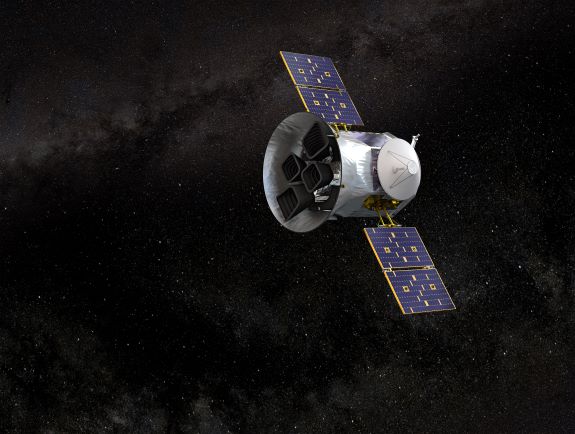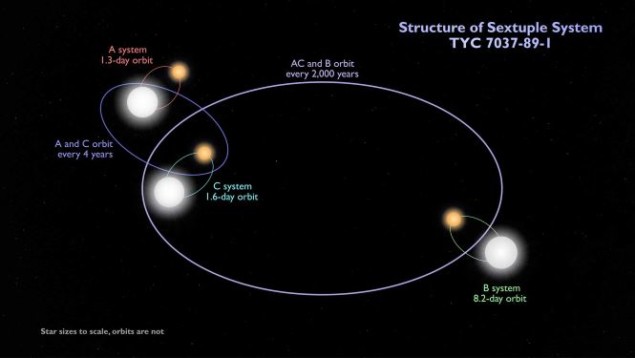
A system of six gravitationally bound stars – each of which eclipses the “partner” star in its binary pair – has been identified by researchers who used machine learning to locate its signal within the vast datasets generated by NASA’s Transiting Exoplanet Survey Satellite (TESS). The discovery of this unusual grouping is both a step forward in our understanding of complex multi-star systems and an example of how artificial intelligence is enhancing astronomical observations.
Although binary and triple star systems are common, groupings of six stars are much less so. Only 18 sextuplet systems have so far been identified, and a sextuply-eclipsing sextuplet system like the one designated TIC 168789840 is rarer still – perhaps even unique. This is because the stars’ orbital plane must be almost edge-on with our line of sight here on Earth for us to see the stars eclipse their partners as they orbit their common centre of mass.
While this alignment is more common in close pairs of stars like the ones that make up TIC 168789840, the probability is still less than 20 per cent, says Brian Powell, a data scientist at NASA’s High-Energy Astrophysics Science Archive Research Center (HEASARC) and co-author of a preprint on the discovery. “The chance that a sextuple would contain all three binaries oriented in such a manner is quite small, not to mention the rarity of the sextuple system formation to begin with,” Powell tells Physics World.
Atypical architecture
At the heart of TIC 168789840 are two pairs of eclipsing binary stars, designated pair A and pair C. Each star in pair A and pair C orbits its partner in a matter of days. Pairs A and C also, collectively, orbit their shared centre of mass. Finally, a third eclipsing binary, pair B, is located farther out and orbits the A–C pair. An eclipse in this system occurs whenever one star in the system is seen to move in front of its fainter partner (a primary eclipse) and then behind it (a secondary eclipse).

To find this six-fold needle in the astronomical haystack, Powell and Veselin Kostov used machine learning and artificial intelligence tools that astrophysicist Alan Smale and other HEASARC staff developed to help identify unusual or complex multiple star systems within the TESS data. This analysis led the NASA Goddard Space Flight Center team to TIC 168789840’s multiple eclipses.
According to Ulrich Kolb, an astrophysicist who studies star formation at the Open University in the UK and was not involved in the discovery, the eclipses in TIC 168789840 are more than just an astronomical curiosity. They also reveal a wealth of information about the six stars that could otherwise only be determined using sophisticated stellar models. “All of [the models] have intrinsic assumptions and ambiguities,” he says. “So finding an eclipsing system like TIC 168789840 is a bit like striking gold.”
Pieces in a puzzle
One puzzling feature of TIC 168789840 is that the primary stars in each of the three binaries all have very similar masses (between 1.22 and 1.30 times the Sun’s mass), radii (between 1.46 and 1.69 solar radii) and temperatures (between 6350 and 6400 K). Their partners, meanwhile, are all K-type stars smaller and cooler than our Sun. Such similarities are “interesting because it is yet another improbable characteristic of this star system”, Powell says.
A further puzzle is that the three pairs of stars in TIC 168789840 orbit one another at relatively close distances. The stars in A and C are 4.8 and 4.2 million kilometres apart respectively, while the stars in the outer binary, B, are separated by 14.9 million kilometres. By way of comparison, Mercury, the innermost planet in our solar system, gets no closer to the Sun than 47 million kilometres.
While closely spaced binary stars are not uncommon, they pose a challenge to star-formation models, which predict that stars should not be able to form within 1.5 billion kilometres (10 AU) of one another. To resolve this apparent contradiction, Andrei Tokovinin, an astronomer at the Cerro Tololo Inter-American Observatory in Chile and a co-author on the present study, suggests that the stars in TIC 168789840 and other close binaries may have formed in other locations and then migrated closer together.
In 2020, Tokovinin and Max Moe of the University of Arizona, US proposed that such migration could be driven by gas accretion from a protostellar nebula surrounding the stars when they are still very young. Because close binaries are often found in triple or quadruple star systems, Tokovinin and Moe suggested that gas accretion could not only drive a binary system closer together but could also provide enough gas to form more stars.
How three stars became six
Tokovinin suggests that a similar thing may have happened in TIC 168789840, but on a grander scale. The similarities between the three primary stars, he says, “prompts the idea that the original primaries, A, B and C, were already forming a bound triple and acquired their companions at the same time, [perhaps] when this triple passed through a dense gas cloud”.
In this scenario, the gas that accreted from the cloud onto the triple system was enough to form the three smaller secondaries. As they formed, this same accretion process led them to migrate inwards, becoming closer to their primary stars. Hence, what started as a triple system, with two stars orbiting one another and a third orbiting them both, became a system of six stars.

Astronomers reveal most detailed atlas of the Milky Way
“TIC 168789840 provides an exceptional laboratory in which to study possible formation scenarios,” Powell says. “It could be the smoking gun for the accretion-migration model of close binaries.” Kolb, for his part, calls the accretion explanation “a plausible scenario that I think makes a lot of sense”.
Alongside Powell, Kostov and Tokovinin, the core data analysis-team also includes Saul Rappaport of the Massachusetts Institute of Technology in the US, Tamás Borkovits of the University of Szeged in Hungary, and Petr Zasche of Charles University in the Czech Republic. Their paper will be published in a forthcoming issue of The Astronomical Journal. But Powell isn’t satisfied with this one result. “As a data scientist, I’m always looking for interesting data [and] TESS is a goldmine of interesting data – more discoveries are being made in the data every day,” he says. “I have very little doubt that there is a larger star system than this one in the data, simply waiting to be found.”



